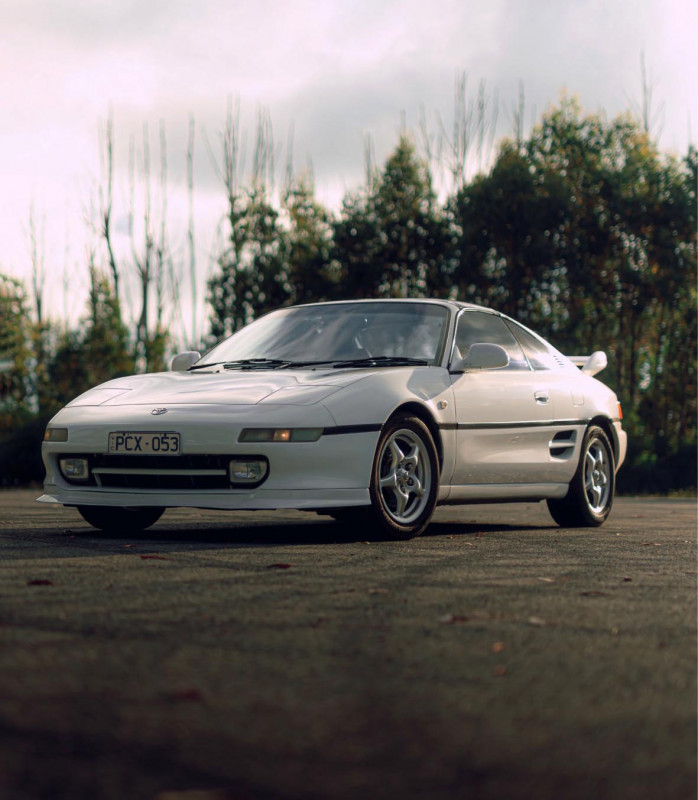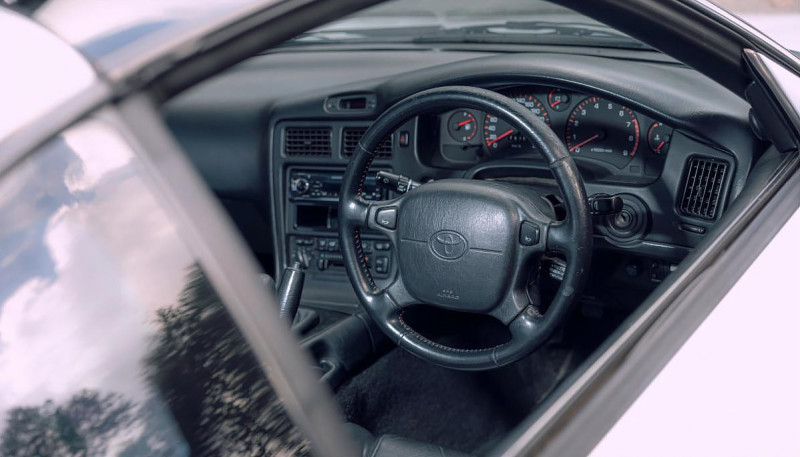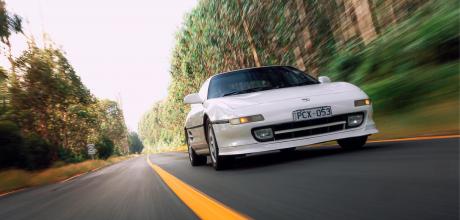1990 Toyota MR2 Turbo SW20
We tell the background story on how Toyota both spoilt and then fixed the MR2.
Overrun
MODERN CLASSIC – TOYOTA MR2
How Toyota tamed the wild side of its mid-engined sportster to finally deliver a chassis that mere mortals could exploit
As screamer headlines went ‘HOW TOYOTA SPOILT THE MR2’ is right up there. Accompanied by a series of pictures of an SW20 MR2 spinning on track, the cover of CAR magazine’s May 1990 edition stuck the knife into Toyota’s box-fresh sportster with 100-point all caps.

In today’s torrent of clickbait, such a headline would barely raise an eyebrow. It’d likely elicit a Jeff Lebowski shrug of ‘that’s just your opinion, man’ before scrolling on. Back then it was enough to permanently cast a shadow over the SW20 MR2’s legacy. But was there any truth to it?
Toyota reacted. Stung by the criticism, it brought a Revision 2 version of the MR2 to market in January 1992. The suspension was altered, wider tyres were specified and JDM models got the option of traction control and, for the Turbo, a viscous LSD.

The turbocharged version was never officially imported to Australia. We had to make do with the atmo 3S-GE 2.0-litre four that had previously seen duty in the Celica SX. Subtly altered valve timing and compression had squeaked a few more kilowatts out of the 16-valve lump though, peak power rising by 14kW to 117kW at 6600rpm and peak torque climbing by 17Nm to a presentable 190Nm at 4800rpm. Curiously, Toyota then undid much of that good work by saddling the five-speed manual transmission with a taller final drive.
Wheels’ first taste of the SW20 in Australia came in March 1990 when Michael Stahl claimed it to be “easier to drive, significantly faster, stops harder, hangs on better and is more forgiving” than its predecessor. He did sound a note of caution, however, claiming that the Japanese press had found their home market Turbo version to be almost uncontrollable in the wet.

The very next month we decided to put Stahly’s initial assessment to the test. Mike McCarthy faced the MR2 against the Mazda MX-5, the Ford Capri Turbo and the Honda CRX and noted that the new Toyota “rides with controlled assurance while handling predictably, more progressively, with better directional stability than the original” ultimately handing the MR2 the crown as best sports car under $40,000. It certainly didn’t sound there as if Toyota had spoilt the MR2.
And then CAR magazine landed. After driving the MR2 at Castle Combe, the highly respected Gavin Green said in his eight-page piece “I have never had so many spins in a road car. Whereas the old car could be taken to the limit, and controlled quite neatly – both by the steering and the throttle – the new car is more vicious on the limit, far less controllable.”
CAR put the blame squarely on a perceived mismatch between the front and rear suspension stiffness, claiming that the rear was too soft in roll, overloading the outside tyre. Looking back, Green stands by the review. “I do recall having a conversation with Simon [Small, Toyota’s UK PR], and he wasn’t very happy. My attitude back then – and it hasn’t changed – is that if you slag off a car you have to be prepared to sit down in front of the MD, PR man, chief engineer etc. and cogently argue why you believe what you’ve written. Mere sensationalism is not acceptable.”
Some elements within Toyota already knew there might be an issue. Veteran US racer Dan Gurney was drafted to develop the SW20 and he recalls a test session at Willow Springs race track with chief engineer Kazutoshi Arima. “It was very windy. I was running the car pretty hard with Mr Arima in the passenger seat. We got off course at Turn Eight (twice) going over 120mph, with tumbleweeds blowing by and he never even flinched. It didn’t take long to find out that the rear end of the car was not very good. It was set up for [city driving] for the wife of one of the designers, which was too soft. The front and rear anti-roll bars were way too small, so we put on larger ones and balanced the car so it didn’t lean as much, making the car much better at high speed.” Cue Arima trying to force these changes through at the eleventh hour, ultimately in vain.
In order to see if CAR’s limit handling complaints had legs, Wheels strapped every piece of data collection gear possible to an MR2 in November 1990 as part of a handling test at Eastern Creek. The results were clear. “A press-on driver can still find himself sideways very, very easily. And that’s the MR2’s downfall,” said Kevin Bartlett. “If you lift your foot for any reason, you’ve got to be very careful how far and how quickly you lift it off. The MR2 has the tendency to turn its tail quite drastically and break into big-time oversteer. It is possible to drive it sideways, but we’re talking about the top five percent of drivers here. Once it breaks the average enthusiast is not going to be quick enough or measured enough in his inputs to bring it back.”
Bartlett reckoned that at up to eight-tenths on road, the MR2 was a “a sweetie”, producing superb levels of grip and rich reward but only up to a point. Beyond that, he concluded, the MR2 is “strictly the province of the expert wheelsmith.” With exactly that behind the wheel, the MR2 aced the handling test, being the quickest and grippiest vehicle present.
So it was clear that the MR2 could reward a great driver, but had some set-up issues that were likely to pitch most of us into a ditch at some point. The fix came with the Rev2 and were far more extensive than just some chunkier anti-roll bars. The suspension was the key recipient of alterations, with the caster angle revised, increasing trail, while upgraded bushes helped maintain camber angle under higher loads.
Yes, chunkier anti-roll bars were fitted front and rear, but the spring rates remained unchanged. The strut mounting points were moved for superior anti-dive effect, the dampers were retuned, the front tie-rod beefed up and rear toe increased by a few millimetres. The rear-most lower suspension arm was lengthened by 90mm to help prevent toeout under braking (or lift-off). If, after all that, the car still oversteered, drivers could rely on a quicker power steering system that saw a reduction in the overall ratio from 20.5:1 to 17.6:1.
Another issue with the steering in the Rev1 was that in lift-off scenarios, the electric power to the steering system could momentarily drop right when you needed it most. In the Rev2, the ECU for the steering was networked to that of the engine, so if the driver turned the wheel quickly without any throttle actuation, the engine would boost the idle speed such that a loss of assistance couldn’t happen.
Bespoke 15-inch Yokohama AO22 tyres replaced the previous 14-inch Bridgestone rubber, with the rear treads widening from 205 to 225mm. Flat-faced five-spoke alloys replaced the more organically curved five-spokes of the Rev1 and the MR2’s aesthetic was also helped by the fact that the suspension changes dropped the ride height by 10mm.
Reviewers were instantly impressed by the Rev2. Autocar and Motor claimed that “although it has to be remembered that the MR2 was never the treacherous beast it was often held out to be, now it is a pussy cat. You’d need to be a fool or extremely unlucky to spin the MR2 on a public road.”
Even CAR recognised that the car had been transformed, noting that “roadholding is strong and positioning the car cleanly to allow hard acceleration out of a curve produces pleasing neutrality, there’s no threat of a slide or a spin should you de-throttle, as was last year’s model’s nasty habit.”
Wheels tested the Rev2 in our April 1993 handling test, with Dick Johnson taking on the likes of the Porsche 968CS, the Nissan Skyline R32 GT-R, the Honda NSX, the BMW M5 and the Mazda RX-7 again at Eastern Creek. The Toyota developed the highest G-forces through the measured corner and second highest cornering speed to the Porsche. Johnson claimed that “through the fast stuff it’s very controllable and you can get it into a four-wheel drift very comfortably. Very neutral… Once you get it to its limit though, it lets go. It gets to a point and then it’s all over, a bit like a Porsche 911. In a lot of cars, you have to put on a lot of lock just to get the attitude on the car before they go anywhere. The MR2 isn’t like that at all – it goes where you point it.”

Toyota continued tweaking the MR2 formula, having fixed the handling. The ‘facelift’ Rev3 was announced in November 1993, boosting power, fitting a passenger airbag and debuting the rounded ‘Kouki’ tail lights. Power lifted to 129kW with updates to the fuel injection, intake, exhaust and valve gear. Two-stage gas dampers were fitted and the suspension geo was again fettled, with caster changes helping straightline stability. This then allowed Toyota to, in effect, reverse the Rev2’s rear toe geometry, the suspension brackets altered to give 2mm less toe-in to help combat mid-corner understeer.
The Rev4 arrived in June 1996, with better ABS and an exhaust gas recirculation system which knocked the atmo 3S-GE back to 125kW in many markets. The final iteration of the SW20, the Rev5 was interesting in that it introduced the 147kW BEAMS version of the 3S-GE.
Without the draw of a turbocharged version, the SW20 rather fizzled here in Australia. A 125kW MR2 Bathurst edition was launched for the domestic market which was 37kg lighter than standard due to featuring cloth seats, with no centre storage bin, no front fog lights, no power steering and cheaper seats yet still retailed at $49,990 in 1998, which was a round ten grand more than the 155kW, all-conquering, all-wheel-drive Subaru Impreza WRX. Not surprising then that it came dead last in a Wheels comparo in March 1998, not because it was a poor car, but because it was overpriced and underspecced.
In many ways, the SW20’s reputation never recovered from CAR magazine’s cover. All but the knife-edge Rev1 cars are huge fun to drive, handle extremely well and reward a skilled hand at the wheel like few other comparable cars. The Turbo defies the old adage of ‘fast, cheap, reliable – pick any two’. Those in the know are quite happy for the market at large to view the SW20 with an element of caution. If you’ve got this far, do us a favour. Keep that under your hat, eh?
Yes, that odo reading is accurate and a testament to owner Thomas Chitty Driven, not hidden. That’s a mantra we can all get behind. By the time this particular version was launched, the SW20’s handling issues were recognised and remedied.
TECHNICAL DATA
- Model Toyota MR2 Turbo
- Engine 1998cc 4cyl, dohc, 16v, turbo
- Max power 180kW at 6600rpm
- Max torque 304Nm at 4800rpm
- Transmission 5-speed manual
- Weight 1310kg
- 0-100km/h 5.4sec
- Price (now) from $25,000
“It is possible to drive it sideways, but we’re talking the top five percent of drivers here” – Kevin Bartlett
THE EDITOR’S CHOICE
I owned a Rev2 GT Turbo imported from Japan, powered by the Yamaha-fettled 3S-GTE lump good for 163kW, which seemed a whole hill of excitement, but doesn’t seem quite so imposing today. It also featured the JDM Bilstein dampers and optional traction control. The Rev3 lifted that output to 180kW, making the MR2 Turbo a quicker car than a Honda NSX, a Ferrari 348tb or a Toyota Supra RZ around Tsukuba, at least according to the occasionally erratic standards of Best Motoring.


